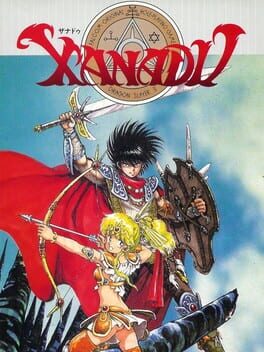

In Legend of Xanadu, the player controls a young adventurer named Areios. Monsters attack his homeland, and he is forced to flee. After traveling by ship and arriving at the town Bolda, Areios finds out that strange things have been happening in the North Cave near the town. His first mission will be to venture to the North Cave and investigate the matter. Of course, soon Areios finds himself involved in a battle against sinister forces, and commences the longest and most dangerous adventure of his life! The game is an action RPG set in the Dragon Slayer universe, with a gameplay style similar to Falcom's other popular series, Ys. Controlling Areios, the player explores the top-down world, visiting towns and fighting monsters in vast outdoor areas and dungeons. Like in Ys series, it is sufficient to "bump" into a monster in order to inflict damage. Areios gains hit points and becomes stronger by sustaining damage from enemies and resting. His weapons and armor can gain experience and level up. In many areas, companions will join Areios and help him in combat, controlled by the computer AI. The game is divided into chapters; the final stage of each chapter is a side-scrolling/platform level, which Areios has to navigate in order to reach the boss enemy, defeat him, and end the chapter. In such stages, the combat turns into a more familiar action-oriented style, with the player being required to press buttons in time in order to execute attacks and jump. There is a day/night cycle in the game, manifested not only in graphical changes, but also in the schedules of townspeople: when it's dark, people will return to their homes and go to sleep, etc.
Reviews View More
Manage your money, manage your items, manage your key stock, manage your karma, manage your level, manage what type of attack you use, manage what items you collect, manage what monsters you kill. Oh, and don't forget map knowledge.
Playing Xanadu blind is brutal and even the official Japanese guide that comes with the game does not explain a number of critical game mechanics and what a number of essential items do. It's your old "figure out for yourself" formula but because the whole "management" game is so tight, you will be resetting the progress quite frequently on your first playthroughs, often times starting a new save. It is a very frustrating experience at first but as you learn each element of the "management" game, it becomes easier to play. However, the gratification is short-lived. Even with maps turning into an absolute mess to navigate in the later half and dungeons increasing in complexity, Xanadu simply starts to feel tedious. There are still a few puzzle pieces left, like finding the best gear and locating the last boss, but the grind and back-tracking you have to do at the final stretch is simply not fun.
I skipped all games that released in-between Dragon Slayer and Xanadu, so I am not sure what kind evolution Falcom games were going through at that time but taking just these two titles, you can clearly see Falcom trying new things and experimenting with different game mechanics. Later they probably realized it is the "action" part of their games (namely, the bump system) that brings most fun and satisfaction and gave it a try with Ys. Conforming to modern gaming standards and trends is something even Falcom cannot resist but I wonder what game mechanic subsequent entries in the Dragon Slayer series decided to prioritize and what a modern Xanadu game would look like.
----------------------------------------
Games played prior: Dragon Slayer (PC88), modern versions of all numbered Ys games, except Ys IX and Ys X, all Kiseki games except Kuro 1/2.
The game itself has little direction, I think i need to just try playing it again with an English translation (I played the untouched Saturn port). I found myself pretty lost after I had out leveled all the area's monsters. I've been told that I need to use a ring to get to the next area. Next time I revisit the game, I'll be sure to do some preparations.
TLDR: This is an old school game that's both really really realllly repetitive and really realllly really obtuse. If you can stomach that, then you'll find this game has a unique, almost addictive allure. But if that's too much, I'd understand. As for me, I will be returning to this game.
Also - this game takes up like nearly 400 blocks in memory on the Sega Saturn, so you might want to manage your blocks a bit before playing.
But is it good? Not really, it's neat though.
